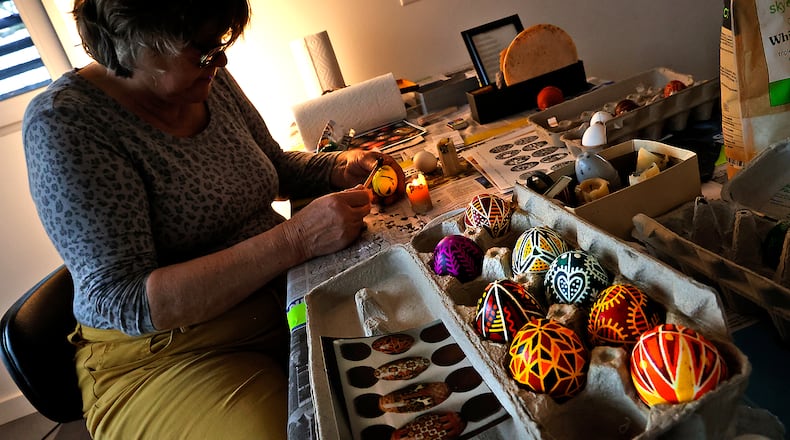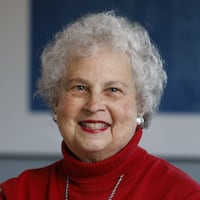Tearfully, she showed a picture of eggs decorated by her children and grandchildren.
“One of those eggs was made by my granddaughter, Linden, the daughter of my son, Timothy,” she explained. “Timothy was the namesake of my grandfather who was killed by the Russians (in the 1930s).”
>> PHOTOS: Ukrainian egg workshop in Springfield
Not long after her presentation, a collection of the family’s eggs was on display at the Ohio Statehouse Rotunda, the Ohio Arts Council’s Riffe Gallery and the DAI.
“The truth about eggs is that they are fragile and everything now is very fragile,” says Pereyma, with her beloved country still under siege. “So Russia trying to break Ukraine is very symbolic. Right now, it’s possible that women in the west of Ukraine are decorating eggs, but people who are refugees and in a war zone are not. People who are fleeing can’t sit and do this peaceful activity.”
Learning an ancient art
Those gathered at the Westcott House’s Solar House in Springfield on March 18 this year had come to learn the ancient form of Ukrainian egg decorating, known as pysanky, and to raise funds for the Ukraine Heritage Response Fund. The fund serves to support the protection of irreplaceable treasures from further damage and post-crisis recovery of cultural heritage sites.
Pereyma, aided by her sister Vaka Farrara, led the workshop, introducing the popular tradition thought to have originated in pre-Christian times. After the arrival of Christianity, the painted eggs were included in the celebration of Easter in the Ukrainian Church and came to represent new life and the Resurrection.
The batik process involves a wax resist technique in which lines and figures are drawn on a fresh egg with melted beeswax using a tool called a kystka. The eggs are then dipped in dye and the process continues with progressively darker dyes until the wax is melted off to reveal the design. Eventually the inside of the egg is hollowed out with a syringe. The delicate nature of real eggs is what makes pysanky eggs so amazing.
Traditional symbols for decorating range from geometric and solar to animals and plants. One of the oldest is the meandering line, a curve that runs continuously over the surface of the egg.
“After 10,000 hours you’ll be capable of doing eggs like this goose egg,” Pereyma told her students, holding up a giant egg. “”If you decorate eggs, you won’t need mindfulness training.” Over the course of the workshop, her students agreed there was definitely something relaxing about the activity.
Karen Day of Columbus attended with her mother. “It’s fun and a challenge to learn something new and it’s nice to learn about another culture,” she said. “We’re enjoying it.”
Vaka Pereyma shared an ancient folk tale. “It says as long as somebody is decorating the eggs, the monster of the world who is chained to a mythical mountain cannot get loose and destroy the world.”
A family tradition
The Pereyma family, with deep roots in Ukraine, has been decorating eggs for generations. Christina’s mother, Aka, who died in 2013 at the age of 86, was a master of the art form who was also known for her large welded outdoor sculptures, murals, ceramics and textiles. She and her husband settled in Troy in 1959. She attended the school at the Dayton Art Institute and School of the Art Institute of Chicago. From 1970 to 1980, she was the artist coordinator for the Welding for Artist Program at the Hobart School for Welding Technology in Troy.
“Every spring starting when I was a child, my mother would get out her tools, start decorating eggs and make an egg tree,” Pereyma explained. “Pysanky literally means the written egg so it’s actually considered writing, not decorating. The tools we use are writing tools. Beeswax was traditionally used because Ukraine continues to be a major producer of honey. "
When an exhibit of Aka’s work was shown at Chicago’s Ukrainian Institute of Modern Art, she told a reporter that several of the works were inspired by Ukrainian folk songs that her mother sang to her as a child. She was labeled a “living cultural treasure” in 2003 when she was honored by the Ohio Arts Council in the first group of Ohio Heritage Fellows.
“She has served as a creative repository of the visual symbolism of Ukrainian culture, much of which was lost in the 20th century,” they said, adding that her work in the Ukrainian pysanky decorated egg tradition was “of the highest quality to be found anywhere in the world.” In 2001, Aka was awarded the Outstanding Ukrainian Artist medal from the Ukrainian government.
After Ukraine became independent in 1991, Aka and her sister, Tanya, traveled there many times with the Cultural Minister of Ukraine, Oleksandra Fedoruk. “He wrote the first book about my mother and the title is ‘The Extraordinary World of Aka Pereyma.’ " Christina says. “Everything about her was extraordinary.”
Christina says although her mother always honored her ties to Ukraine, when speaking publicly she always acknowledged that she would never have been able to live such a fantastic life of prosperity and peace if she hadn’t lived in America.
Christina, who gives all of her finished eggs away and never sells them, says carrying on the tradition connects her to the past and her heritage. “I don’t need a DNA test to know who I am,” she says.
The Pereyma family believes those who practice the ancient art are communicating with their eggs. “It’s profound and magical, a connection to the spirit of rebirth,” Christina says. " It’s a new life coming from an inert object. If you ever saw a baby chick emerge from the egg, you know it’s magic!”
See the exhibit
The Easter eggs made by the members at the recent pysanky workshop will be on display through Sunday, April 16 at the Frank Lloyd Wright Westcott House, 85 Greenmount Avenue, Springfield.
For more information about the house and future workshops, check westcotthouse.org.
About the Author


